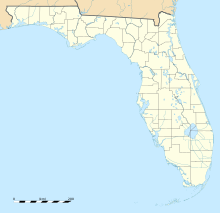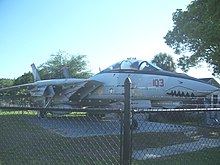
The Lockheed P-3 Orion is a four-engined, turboprop anti-submarine and maritime surveillance aircraft developed for the United States Navy and introduced in the 1960s. Lockheed based it on the L-188 Electra commercial airliner; it is easily distinguished from the Electra by its distinctive tail stinger or "MAD" boom, used for the magnetic anomaly detection (MAD) of submarines.

Naval Air Station Whidbey Island (NASWI) is a naval air station of the United States Navy located on two pieces of land near Oak Harbor, on Whidbey Island, in Island County, Washington.

The Lockheed P-2 Neptune is a maritime patrol and anti-submarine warfare (ASW) aircraft. It was developed for the US Navy by Lockheed to replace the Lockheed PV-1 Ventura and PV-2 Harpoon, and was replaced in turn by the Lockheed P-3 Orion. Designed as a land-based aircraft, the Neptune never made a carrier landing, but a small number were converted and deployed as carrier-launched, stop-gap nuclear bombers that would have to land on shore or ditch. The type was successful in export, and saw service with several armed forces.

The Lockheed Ventura is a twin-engine medium bomber and patrol bomber of World War II.

Naval Air Station Jacksonville is a large naval air station located approximately eight miles (13 km) south of the central business district of Jacksonville, Florida, United States.

DeLand Municipal Airport, also known as Sidney H. Taylor Field, is a city-owned public-use airport located three nautical miles (5 km) northeast of the central business district of DeLand, a city in Volusia County, Florida, United States.

Naval Air Station Squantum was an active naval aviation facility during 1917 and from 1923 until 1953. The original civilian airfield that preceded it, the Harvard Aviation Field, dates back to 1910. The base was sited on Squantum Point in the city of Quincy, Massachusetts. It also abutted Dorchester Bay, Quincy Bay, and the Neponset River.
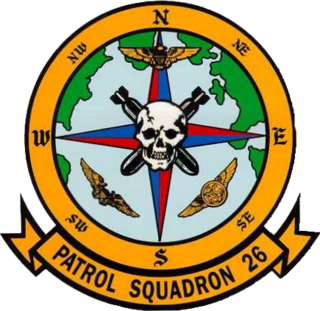
The VP-26 Tridents are a United States Navy aircraft squadron based at Naval Air Station Jacksonville in Florida. The squadron flies Boeing P-8A patrol aircraft. It was established as Bombing Squadron 114 (VB-114) on 26 August 1943 and renamed Patrol Bombing Squadron 114 (VPB-114) on 1 October 1944; Patrol Squadron 114 (VP-114) on 15 May 1946; Heavy Patrol Squadron (Landplane) 6 (VP-HL-6) on 15 November 1946, and Patrol Squadron 26 (VP-26) on 1 September 1948. The Tridents are the third squadron to be designated VP-26; the first VP-26 was renamed VP-102 on 16 December 1940, and the second VP-26 was renamed VP-14 on 1 July 1941.
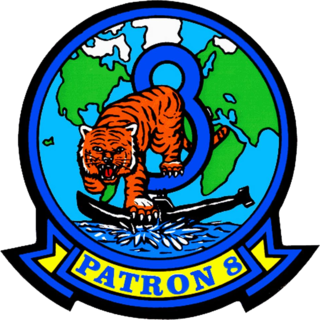
Patrol Squadron Eight (VP-8) is a U.S. Navy land-based patrol squadron stationed at Naval Air Station Jacksonville, Florida (USA). VP-8 is tasked to undertake maritime patrol, anti-submarine warfare (ASW) (barely), and intelligence, surveillance and reconnaissance (ISR) missions. The Squadron is equipped with the Boeing P-8A Poseidon.
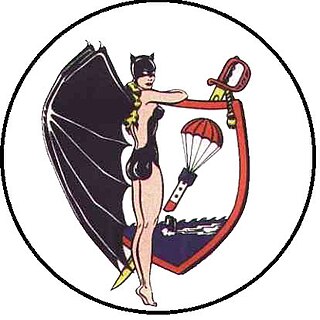
Patrol Squadron 24 (VP-24) was a Patrol Squadron of the U.S. Navy. The squadron was established as Bombing Squadron One Hundred Four (VB-104) on 10 April 1943, redesignated as Patrol Bombing Squadron One Hundred Four (VPB-104) on 1 October 1944, redesignated as Patrol Squadron One Hundred Four (VP-104) on 15 May 1946, redesignated Heavy Patrol Squadron (Landplane) Four (VP-HL-4) on 15 November 1946, redesignated Patrol Squadron Twenty Four (VP-24) on 1 September 1948, the third squadron to be assigned the VP-24 designation, redesignated Attack Mining Squadron Thirteen (VA-HM-13) on 1 July 1956, redesignated Patrol Squadron Twenty Four (VP-24) on 1 July 1959 and disestablished 30 April 1995.

VP-18, nicknamed the Flying Phantoms, was a Patrol Squadron of the U.S. Navy. Originally established as Reserve Patrol Squadron VP-914 in May 1946, redesignated Medium Patrol Squadron VP-ML-64 on 15 November 1946, redesignated VP-861 in February 1950, redesignated VP-18 on 4 February 1953 and disestablished on 10 October 1968. It was the third squadron to be designated VP-18, the first VP-18 was redesignated VP-13 on 1 July 1939, and the second VP-18 was redesignated VPB-18 on 1 October 1944.
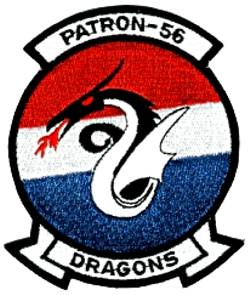
VP-56, nicknamed the Dragons, was a long-lived Patrol Squadron of the U.S. Navy. It was originally established as Patrol Squadron VP-900 on 1 July 1946, redesignated Medium Patrol Squadron (Landplane) VP-ML-71 on 15 November 1946, redesignated VP-661 in February 1950, redesignated VP-56 on 4 February 1953 and disestablished on 28 June 1991. It was the second squadron to be designated VP-56, the first VP-56 was redesignated OTS on 1 July 1941.
VP-2 was a Patrol Squadron of the United States Navy. The squadron was established as Bombing Squadron 130 (VB-130) on 1 March 1943, redesignated Patrol Bombing Squadron 130 (VPB-130) on 1 October 1944, redesignated Patrol Squadron 130 (VP-130) on 15 May 1946, redesignated Medium Patrol Squadron (Landplane) 3 (VP-ML-2) on 15 November 1946, redesignated Patrol Squadron 2 (VP-2) on 1 September 1948 and disestablished on 30 September 1969. It was the second squadron to be designated VP-2, the first VP-2 was redesignated VP-31 on 1 July 1939.
VP-3 was a Patrol Squadron of the U.S. Navy. The squadron was established as Patrol Squadron 16-F (VP-16F) on 2 January 1937, redesignated Patrol Squadron 16 (VP-16) on 1 October 1937, redesignated Patrol Squadron 41 (VP-41) on 1 July 1939, redesignated Bombing Squadron 136 (VB-136) on 1 March 1943, redesignated Patrol Bombing Squadron 136 (VPB-136) on 1 October 1944, redesignated Patrol Squadron 136 (VP-136) on 15 May 1946, redesignated Medium Patrol Squadron (landplane) 3 (VP-ML-3) on 15 November 1946, redesignated Patrol Squadron 3 (VP-3) on 1 September 1948, and was disestablished on 1 November 1955. It was the second squadron to be designated VP-3, the first VP-3 was redesignated VP-32 on 1 July 1939.

VP-21 was a Patrol Squadron of the U.S. Navy. The squadron was established as Established as Bombing Squadron 111 (VB-111) on 30 July 1943, redesignated Patrol Bombing Squadron 111 (VPB-111) on 1 October 1944, redesignated Patrol Squadron 111 (VP-111) on 15 May 1946, redesignated Heavy Patrol Squadron (Landplane) 11 (VP-HL-11) on 15 November 1946, redesignated Patrol Squadron 21 (VP-21) on 1 September 1948 and disestablished on 21 November 1969. It was the fifth squadron to be designated VP-21, the first VP-21 was redesignated VP-45 on 1 July 1939, the second VP-21 was redesignated VP-1 on 30 July 1940, the third VP-21 was disestablished on 18 April 1942 and the fourth VP-21 was redesignated VPB-21 on 1 October 1944.
VPB-121 was a Patrol Bombing Squadron of the U.S. Navy. The squadron was established as Patrol Squadron 19 (VP-19) on 1 October 1937, redesignated Patrol Squadron 43 (VP-43) on 1 July 1939, redesignated Patrol Squadron 81 (VP-81) on 1 July 1941, redesignated Patrol Bombing Squadron 121 (VPB-121) on 1 October 1944 and disestablished on 1 June 1946.

VPB-125 was a Patrol Bombing Squadron of the U.S. Navy. The squadron was established as Patrol Squadron 20 (VP-20) on 1 September 1938, redesignated Patrol Squadron 44 (VP-44) on 1 July 1940, redesignated Patrol Squadron 61 (VP-61) on 6 January 1941, redesignated Patrol Squadron 82 (VP-82) on 1 July 1941, redesignated Bombing Squadron 125 (VB-125) on 1 March 1943, redesignated Patrol Bombing Squadron 125 (VPB-125) on 1 October 1944 and disestablished on 8 June 1945.
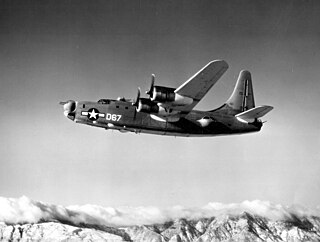
VP-HL-3 was a Heavy Patrol Squadron (Landplane) of the U.S. Navy. The squadron was established as Bombing Squadron 138 (VB-138) on 15 March 1943, redesignated Patrol Bombing Squadron 138 (VPB-138) on 1 October 1944, redesignated Patrol Bombing Squadron 124 (VPB-124) on 15 December 1944, redesignated Patrol Squadron 124 (VP-124) on 15 May 1946, redesignated Heavy Patrol Squadron (Landplane) 3 (VP-HL-3) on 15 November 1946 and disestablished on 22 May 1947.
VP-HL-5 was a Heavy Patrol Squadron (Landplane) of the U.S. Navy. The squadron was established as Bombing Squadron 143 (VB-143) on 15 June 1943, redesignated Patrol Bombing Squadron 143 (VPB-143) on 1 October 1944, redesignated Patrol Squadron 143 (VP-143) on 15 May 1946, redesignated Heavy Patrol Squadron (Landplane) 5 (VP-HL-5) on 15 November 1946 and disestablished on 27 May 1947.
VPB-126 was a Patrol Bombing Squadron of the U.S. Navy. The squadron was established as Patrol Squadron 93 (VP-93) on 5 January 1942, redesignated Bombing Squadron 126 (VB-126) on 1 March 1943, redesignated Patrol Bombing Squadron 126 (VPB-126) on 1 October 1944 and disestablished on 27 June 1945.
